In the more than two hundred years since Benjamin Franklin was appointed our first Postmaster General in 1775, the Postal Service™ has grown and changed with America. Not only have there been changes in moving the mail (ranging from the basic horse and rider Pony Express, to stagecoaches, trains, boats, airplanes, and even dog sled), but there have also been changes in post office buildings. The types of buildings used, and the architecture of Nebraska post offices through the years can easily be seen in the many photographs and postcards found in
Nebraska Memories.
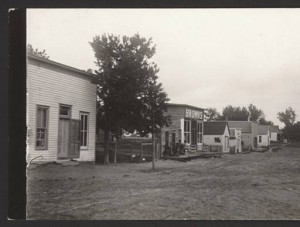
This first picture, taken by Nebraska photographer
John Nelson, shows an early 1900’s Nebraska town with a dirt street lined with buildings. One of the stores has a sign on it that says, “Brown’s” which was also the post office.
It was not uncommon for a general store to serve as the town post office as well. The building in this picture, with its’ plain front and wooden sidewalk, was not many years removed from and not much changed from frontier days style buildings.
Many buildings and businesses did double and even triple duty, like this undertaker, furniture and post office storefront in
Papillion, Nebraska, circa 1907.
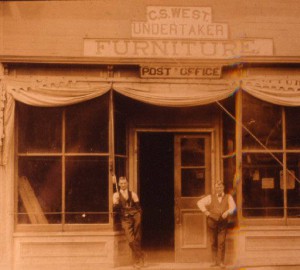
The building was located on the west side of Washington Street between First and Second Streets, but had a little more “modern” store front with big plate glass windows. Charles West (probably the man on the right) served as the Postmaster of Papillion from 1901 to 1914. The man on the left is an unidentified clerk.
This next photograph shows another style of wooden building with a sign identifying it as the
Loomis post office. A long wooden porch covered by an awning runs the length of the building. The postmaster, Gust F. Carlson, stands on the porch, leaning against one of the awning’s support poles. Three other men stand with him, including Axel Veegert (second from right), a mail carrier. A car is parked on the dirt road in front of the building, with a container labeled “U.S. Mail” attached to its side.
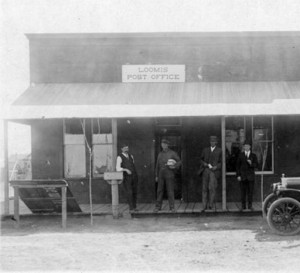
Wooden buildings gradually gave way to larger and more grand buildings, as evidenced by these photographs from
Fremont,
David City, and
Omaha, respectively.
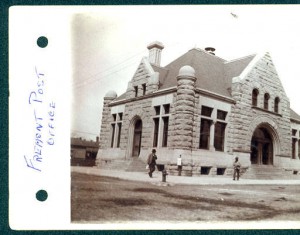
This
Fremont post office building was on the northwest corner of Sixth and Broad Streets, built in 1893 in the more ornate Richardsonian Romanesque style. This style included the hipped roof with parapeted gable dormers, windows with rounded tops, deep-set windows with transoms, arched entries, and the contrasting smooth and rough wall textures.
The
David City post office was a one-story red brick building with wide steps leading to white double entry doors with arched contrasting brick-work above, arched windows with matching trim at each side of the door and smaller double-hung windows on the front and sides of the building, bushes around the foundation and lawn on two sides of the corner lot, a street light in front, sidewalks on two sides with brick streets in front.
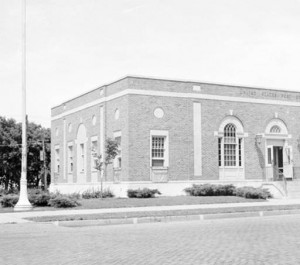
The postcard below, circa 1914, of the South Omaha branch of the post office, was located at 502 North 24th Street in South Omaha, Nebraska. The building was red brick, two stories tall, with arched windows and doors on the first floor and six columns on the front.
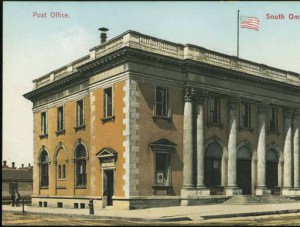
The layout of the interiors of buildings that were used as post offices are of interest as well, as seen in the following pictures.
The post Office in
Spalding, Nebraska had a long cabinet with many pigeon-holes stuffed with letters, and the postmaster’s desk in front;
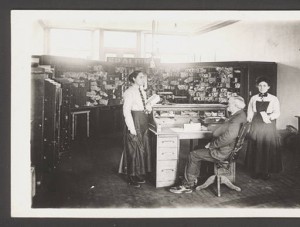
while another Post Office photograph shows a “Reading Room” where people could sit down at a desk to read their letters.
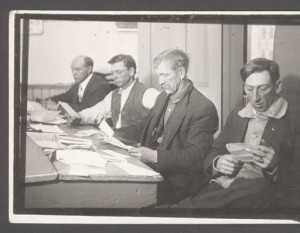
There is also this photograph of what the post office boxes at the back of the
Potter, Nebraska general store looked like:
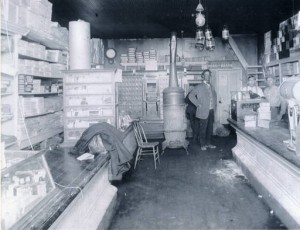
Thanks for joining me today as we journeyed back to look at Nebraska post office buildings from the past 100+ years. I hope you enjoyed it as much as I did!
Visit
Nebraska Memories to search for or browse through many more historical images digitized from photographs, negatives, postcards, maps, lantern slides, books and other materials.
Nebraska Memories is a cooperative project to digitize Nebraska-related historical and cultural heritage materials and make them available to researchers of all ages via the Internet. Nebraska Memories is brought to you by the Nebraska Library Commission. If your institution is interested in participating in Nebraska Memories, see
http://nlc.nebraska.gov/nebraskamemories/participation.aspx for more information, or contact
Beth Goble, Historical Projects Librarian, or
Devra Dragos, Technology & Access Services Director.
 This first picture, taken by Nebraska photographer John Nelson, shows an early 1900’s Nebraska town with a dirt street lined with buildings. One of the stores has a sign on it that says, “Brown’s” which was also the post office.
It was not uncommon for a general store to serve as the town post office as well. The building in this picture, with its’ plain front and wooden sidewalk, was not many years removed from and not much changed from frontier days style buildings.
Many buildings and businesses did double and even triple duty, like this undertaker, furniture and post office storefront in Papillion, Nebraska, circa 1907.
This first picture, taken by Nebraska photographer John Nelson, shows an early 1900’s Nebraska town with a dirt street lined with buildings. One of the stores has a sign on it that says, “Brown’s” which was also the post office.
It was not uncommon for a general store to serve as the town post office as well. The building in this picture, with its’ plain front and wooden sidewalk, was not many years removed from and not much changed from frontier days style buildings.
Many buildings and businesses did double and even triple duty, like this undertaker, furniture and post office storefront in Papillion, Nebraska, circa 1907.  The building was located on the west side of Washington Street between First and Second Streets, but had a little more “modern” store front with big plate glass windows. Charles West (probably the man on the right) served as the Postmaster of Papillion from 1901 to 1914. The man on the left is an unidentified clerk.
This next photograph shows another style of wooden building with a sign identifying it as the Loomis post office. A long wooden porch covered by an awning runs the length of the building. The postmaster, Gust F. Carlson, stands on the porch, leaning against one of the awning’s support poles. Three other men stand with him, including Axel Veegert (second from right), a mail carrier. A car is parked on the dirt road in front of the building, with a container labeled “U.S. Mail” attached to its side.
The building was located on the west side of Washington Street between First and Second Streets, but had a little more “modern” store front with big plate glass windows. Charles West (probably the man on the right) served as the Postmaster of Papillion from 1901 to 1914. The man on the left is an unidentified clerk.
This next photograph shows another style of wooden building with a sign identifying it as the Loomis post office. A long wooden porch covered by an awning runs the length of the building. The postmaster, Gust F. Carlson, stands on the porch, leaning against one of the awning’s support poles. Three other men stand with him, including Axel Veegert (second from right), a mail carrier. A car is parked on the dirt road in front of the building, with a container labeled “U.S. Mail” attached to its side.  Wooden buildings gradually gave way to larger and more grand buildings, as evidenced by these photographs from Fremont, David City, and Omaha, respectively.
Wooden buildings gradually gave way to larger and more grand buildings, as evidenced by these photographs from Fremont, David City, and Omaha, respectively.
 This Fremont post office building was on the northwest corner of Sixth and Broad Streets, built in 1893 in the more ornate Richardsonian Romanesque style. This style included the hipped roof with parapeted gable dormers, windows with rounded tops, deep-set windows with transoms, arched entries, and the contrasting smooth and rough wall textures.
The David City post office was a one-story red brick building with wide steps leading to white double entry doors with arched contrasting brick-work above, arched windows with matching trim at each side of the door and smaller double-hung windows on the front and sides of the building, bushes around the foundation and lawn on two sides of the corner lot, a street light in front, sidewalks on two sides with brick streets in front.
This Fremont post office building was on the northwest corner of Sixth and Broad Streets, built in 1893 in the more ornate Richardsonian Romanesque style. This style included the hipped roof with parapeted gable dormers, windows with rounded tops, deep-set windows with transoms, arched entries, and the contrasting smooth and rough wall textures.
The David City post office was a one-story red brick building with wide steps leading to white double entry doors with arched contrasting brick-work above, arched windows with matching trim at each side of the door and smaller double-hung windows on the front and sides of the building, bushes around the foundation and lawn on two sides of the corner lot, a street light in front, sidewalks on two sides with brick streets in front.  The postcard below, circa 1914, of the South Omaha branch of the post office, was located at 502 North 24th Street in South Omaha, Nebraska. The building was red brick, two stories tall, with arched windows and doors on the first floor and six columns on the front.
The postcard below, circa 1914, of the South Omaha branch of the post office, was located at 502 North 24th Street in South Omaha, Nebraska. The building was red brick, two stories tall, with arched windows and doors on the first floor and six columns on the front.  The layout of the interiors of buildings that were used as post offices are of interest as well, as seen in the following pictures.
The post Office in Spalding, Nebraska had a long cabinet with many pigeon-holes stuffed with letters, and the postmaster’s desk in front;
The layout of the interiors of buildings that were used as post offices are of interest as well, as seen in the following pictures.
The post Office in Spalding, Nebraska had a long cabinet with many pigeon-holes stuffed with letters, and the postmaster’s desk in front;  while another Post Office photograph shows a “Reading Room” where people could sit down at a desk to read their letters.
while another Post Office photograph shows a “Reading Room” where people could sit down at a desk to read their letters.  There is also this photograph of what the post office boxes at the back of the Potter, Nebraska general store looked like:
There is also this photograph of what the post office boxes at the back of the Potter, Nebraska general store looked like: Thanks for joining me today as we journeyed back to look at Nebraska post office buildings from the past 100+ years. I hope you enjoyed it as much as I did!
Visit Nebraska Memories to search for or browse through many more historical images digitized from photographs, negatives, postcards, maps, lantern slides, books and other materials.
Nebraska Memories is a cooperative project to digitize Nebraska-related historical and cultural heritage materials and make them available to researchers of all ages via the Internet. Nebraska Memories is brought to you by the Nebraska Library Commission. If your institution is interested in participating in Nebraska Memories, see http://nlc.nebraska.gov/nebraskamemories/participation.aspx for more information, or contact Beth Goble, Historical Projects Librarian, or Devra Dragos, Technology & Access Services Director.
Thanks for joining me today as we journeyed back to look at Nebraska post office buildings from the past 100+ years. I hope you enjoyed it as much as I did!
Visit Nebraska Memories to search for or browse through many more historical images digitized from photographs, negatives, postcards, maps, lantern slides, books and other materials.
Nebraska Memories is a cooperative project to digitize Nebraska-related historical and cultural heritage materials and make them available to researchers of all ages via the Internet. Nebraska Memories is brought to you by the Nebraska Library Commission. If your institution is interested in participating in Nebraska Memories, see http://nlc.nebraska.gov/nebraskamemories/participation.aspx for more information, or contact Beth Goble, Historical Projects Librarian, or Devra Dragos, Technology & Access Services Director.

